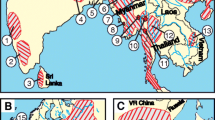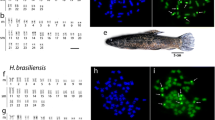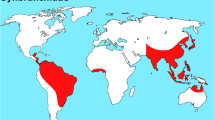Abstract
The Astyanax species of the bimaculatus group include morphologically similar representatives that share the same color pattern, corresponding to at least 20 species. Specimens from the São Francisco River basin and from the Grande River (Upper Paraná basin) are included in this group. In the early 1960’s, the Piumhi River, an original tributary of the Grande River, was transposed to the São Francisco River basin due to the construction of the Furnas Hydroelectric Power, in the state of Minas Gerais, Brazil. In this context, we characterized representatives of the bimaculatus group from both basins and from the transposition region of the Piumhi River, using chromosome characteristics obtained by conventional analyzes and fluorescence in situ hybridization with rDNA probes. All the analyzed specimens presented 2n = 50 chromosomes and similar localization of the nucleolus organizer regions (Ag-NORs), 18S rDNA and 5S rDNA sites. However, diagnostic chromosome differences were detected concerning the number of submetacentric and acrocentric chromosomes in the karyotypes, making possible the characterization of five distinct karyotypes (Cytotypes A–E), where the specimens from the São Francisco and from the Grande River correspond to Cytotypes A and B, respectively. In addition, these two Cytotypes were sympatrically found in the Piumhi River with specimens carrying a clear intermediate karyotype (Cytotype C), as well as with others harboring different karyotypes (Cytotypes D and E). Our data indicate that Cytotypes A and B probably diverged from each other during the prior geographic isolation. However, despite their chromosomal differentiations, they still maintain a close relationship which allows interbreeding and the formation of a secondary hybrid zone, due to the breakdown of the geographic isolation.





Similar content being viewed by others
References
Alberdi AJ, Fenocchio AS (1997) Karyotypes of five Tetragonopterinae species (Pisces, Characidae) from Argentina. Cytologia 62:171–176
Almeida-Toledo LF, Ozouf-Costaz C, Foresti F, Bonillo C, Porto-Foresti F, Daniel-Silva MFZ (2002) Conservation of the 5S bearing chromosome pair and co-localization with major rDNA clusters in five species of Astyanax (Pisces, Characidae). Cytogenet Genome Res 97:229–233
Bellafronte E, Moreira-Filho O, Vicari MR, Artoni RF, Bertollo LAC, Margarido VP (2010) Cytogenetic identification of invasive fish species following connections between hydrographic basins. Hydrobiologia 649:347–354
Bertollo LAC, Takahashi CS, Moreira-Filho O (1978) Cytotaxonomic considerations on Hoplias lacerdae (Pisces, Erythrinidae). Braz J Genet 1:103–120
Blanco DR, Lui RL, Bertollo LAC, Diniz D, Moreira-Filho O (2010) Characterization of invasive fish species in a river transposition region: evolutionary chromosome studies in the genus Hoplias (Characiformes, Erythrinidae). Rev Fish Biol Fish 20:1–8
Buckup PA (2011) The Eastern Brazilian shield. In: Albert JS, Reis RE (eds) Historical biogeography of Neotropical freshwater fishes. University of California Press, Berkeley, pp 203–210
Daniel-Silva MFZ (2001) Análises citogenéticas comparativas em Characidae (Pisces, Characiformes). PhD Thesis, Instituto de Biociências, Universidade de São Paulo
Domingues MS, Vicari MR, Abilhoa V, Wamser JP, Cestari MM, Bertollo LAC, Almeida MC, Artoni RF (2007) Cytogenetic and comparative morphology of two allopatric populations of Astyanax altiparanae Garutti & Britski, 2000 (Teleostei: Characidae) from upper Paraná basin. Neotrop Ichthyol 5:37–44
Eigenmann CH (1921) The American Characidae. Mem Mus Comp Zool 43(3):209–310; pl., 30–32, 40–55, 61, 62, 64, 66, 69, 85, 87, 89, 92
Fernandes CA, Martins-Santos IC (2004) Cytogenetic studies in two populations of the Astyanax altiparanae (Pisces, Characiformes). Hereditas 141:328–332
Fernandes CA, Martins-Santos IC (2006) Mapping of the 18S and 5S ribosomal RNA genes in Astyanax altiparanae Garutti & Britski, 2000 (Teleostei, Characidae) from the Upper Paraná River basin, Brazil. Genet Mol Biol 29:464–468
Froese R, Pauly D (eds) (2011) FishBase. World Wide Web electronic publication. www.fishbase.org, version (10/2011)
Garutti V, Britski HA (2000) Descrição de uma espécie nova de Astyanax (Teleostei, Characidae) da bacia do alto rio Paraná e considerações sobre as demais espécies do gênero na bacia. Comun Mus Ciênc PUCRS. Série Zoologia 13:65–88
Hatanaka T, Galetti PM Jr (2004) Mapping of the 18S and 5S ribosomal RNA genes in the fish Prochilodus argenteus, Agassiz, 1829 (Characiformes, Prochilodontidae). Genetica 122:239–244
Howell WM, Black DA (1980) Controlled silver staining of Nucleolus Organizer Regions with protective colloidal developer: a one-step method. Experientia 36:1014–1015
Jin SM, Toledo V (1975) Citogenética de Astyanax fasciatus e Astyanax bimaculatus (Characidae, Tetragonopterinae). Ciênc Cult 27:1122–1124
Jorge LC, Moreira-Filho O (2001) Estudios citogenéticos en Astyanax bimaculatus (Pisces, Characidae) del río Paraná, Argentina. Ictiologia 9(1/2):21–24
Kantec DLZ, Peres WAM, Buckup PA, Moreira-Filho O (2009) Cytogenetic of Imparfinis schubarti (Siluriformes; Heptapteridae) from the Piumhi drainage, a diverted river in Minas Gerais State, Brazil. Zoologia 26:733–738
Levan A, Fredga KE, Sandberg HA (1964) Nomenclature for centromeric position on chromosomes. Hereditas 52:201–220
Mallet J (2007) Hybrid speciation. Nature 446:279–283
Martins C, Galetti PM Jr (2001) Organization of 5S rDNA in species of the fish Leporinus: two different genomic locations are characterized by distinct nontranscribed spacers. Genome 44:903–910
Melo FAG (2001) Revisão taxonômica das espécies do gênero Astyanax Baird e Girard 1854 (Teleostei, Characiformes, Characidae) da região da Serra dos Órgãos. Arq Mus Nac Rio de Janeiro 59:1–46
Moreira-Filho O, Buckup PA (2005) A poorly known case of watershed transposition between the São Francisco and Upper Paraná River basins. Neotrop Ichthyol 3:445–448
Morelli S, Bertollo LAC, Foresti F, Moreira-Filho O, Toledo-Filho SA (1983) Cytogenetic considerations on the genus Astyanax (Pisces, Characidae). I. Karyotypic variability. Caryologia 36:235–244
Pacheco RB, Giuliano-Caetano L, Dias AL (2001) Cytotypes and multiples NORs in an Astyanax altiparanae population (Pisces, Tetragonopterinae). Chromosome Sci 5:109–114
Paganelli HH (1990) Diversidade cromossômica no gênero Astyanax, com especial referência a A. bimaculatus (Linnaeus 1758): Considerações citotaxonômicas e evolutivas. Master Thesis, Universidade Federal de São Carlos
Peres WAM, Buckup PA, Kantek DLZ, Bertollo LAC, Moreira-Filho O (2009) Chromosomal evidence of downstream dispersal of Astyanax fasciatus (Characiformes, Characidae) associated with river shed interconnection. Genetica 137:305–311
Pinkel D, Straume T, Gray JW (1986) Cytogenetic analysis using quantitative, high-sensitivity, fluorescence hybridization. Proc Natl Acad Sci USA 83:2934–2938
Sumner AT (1972) A simple technique for demonstrating centromeric heterochromatin. Exp Cell Res 75:304–306
Acknowledgments
The authors thank to Luis Henrique da Silva and Pedro Luis Gallo for the help in the fish collections; to the Instituto Brasileiro do Meio Ambiente e dos Recursos Naturais Renováveis (IBAMA—License number 10538-1) and Instituto Estadual de Florestas (IEF/MG) for the collection’ authorizations. This study was supported by Fundação de Amparo à Pesquisa do Estado de São Paulo—FAPESP (Proc. 05/58630-3) and by Conselho Nacional de Desenvolvimento Científico e Tenoclógico—CNPq, through research projects granted to OMF, LACB and PAB.
Author information
Authors and Affiliations
Corresponding author
Rights and permissions
About this article
Cite this article
Peres, W.A.M., Bertollo, L.A.C., Buckup, P.A. et al. Invasion, dispersion and hybridization of fish associated to river transposition: karyotypic evidence in Astyanax “bimaculatus group” (Characiformes: Characidae). Rev Fish Biol Fisheries 22, 519–526 (2012). https://doi.org/10.1007/s11160-011-9246-2
Received:
Accepted:
Published:
Issue Date:
DOI: https://doi.org/10.1007/s11160-011-9246-2




